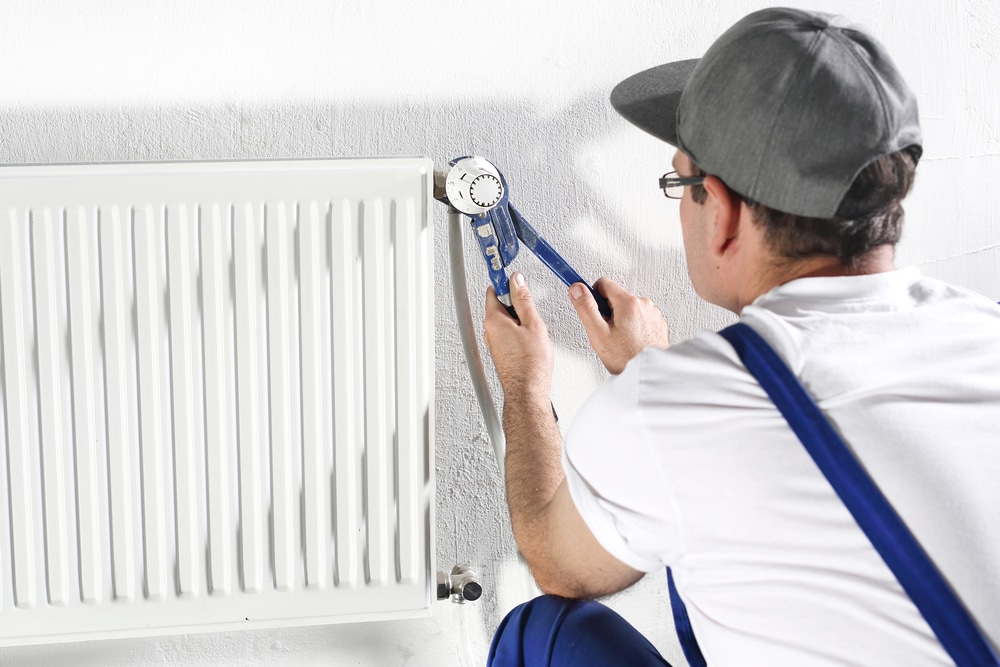Last Updated on January 10, 2023
Bathrooms can quickly get cold in the winter, making you want to stay longer in the shower or bath. Fortunately, there are plenty of ways to keep warm. Let’s discuss how to install a bathroom heater so you can stay warm during these freezing months.
Different Types of Bathroom Heaters
There are various bathroom heaters to choose from, each boasting its own set of pros and cons. Below are some of the most popular heater systems to consider and how to install them.
Panel Heaters
 Bathroom panel heaters provide an effective heating solution while adding a designer look. They’re available in a range of sizes and are the perfect solution to cold bathrooms. They typically have a vertical or horizontal design, with the vertical heaters taking up minimal room in your bathroom.
Bathroom panel heaters provide an effective heating solution while adding a designer look. They’re available in a range of sizes and are the perfect solution to cold bathrooms. They typically have a vertical or horizontal design, with the vertical heaters taking up minimal room in your bathroom.
Most panel heaters are made from steel, which provides a reliable and durable material. The most significant benefit of this type of bathroom heater is that it looks stylish and provides a high heat output level to ensure that your bathroom remains warm all year round.
Installing Panel Heaters
You won’t necessarily need a professional to install a panel heater since most come with an instruction manual and installation kit. The process only requires drilling holes into the wall and mounting it with screws provided with your purchase.
The most critical part of installing this type of bathroom heater is finding the wall’s proper location. It doesn’t need to be high above the wall and can be placed in a lower position. For the installation, find the studs on the wall first and drill the holes. You’ll need to hold the panel firmly in place while tightening the screws.
Towel Radiators
Although this heater’s name suggests that it’ll only heat towels, these wall-mounted bathroom heaters are more practical than central heating. Providing plenty of warm air for your bathroom, they can also keep your towels and clothes dry. Although, if you have a large-sized bathroom, you may need more than one.
They’re less intrusive than traditional radiators and are streamlined, although you may need plenty of spare space on the wall before installation. Fortunately, there are many sizes and designs available.
View this post on Instagram
Installing Towel Radiators
The most efficient and easiest way to install towel radiators is to remove your old radiator and choose a new one with the same width. Therefore, you don’t have to take up the flooring and remove skirting boards for installation.
Your towel radiator will connect to your home’s existing pipework. Still, if you replace the current radiator with a broader version, you may have to drain the system and make pipework alterations. In which case, drain the system before installing and removing the flooring and skirting to reach the required pipework.
Leave at least 20 cm between the bottom rail and the floor. Ensure that the wall and new fixtures are durable and suitable enough to withstand the new radiator’s weight once it’s filled with water. For the best installation results, use a chrome-plated copper pipe to cover the visible pipe’s section that you won’t be replacing.
Electric Heaters
With electric heaters in your bathroom, you don’t need to use your home’s central heating system. It can save you a lot of money in the long run. You can purchase a bathroom heater that suits your needs and budget. For example, some come with an on-off switch, which means that the appliance will automatically turn on when the room becomes cold.
Installing an Electric Heater
To install and connect this type of bathroom heater, you’ll require a professional plumber or electrician unless you’re qualified yourself. It is essential because this bathroom heater needs to adhere to specific safety regulations. These include the device not being too close to the shower and within safe reach of a plug.
Moreover, you can install this type of electric heater on the wall, so long as it’s installed in the correct bathroom zone and all fittings are securely attached to the radiator.
Underfloor Heating
Underfloor heating has a higher cost than the above wall-mounted heaters, although they’ve grown increasingly popular. There are two types of underfloor heating to consider: dry system and wet system. The former uses electrical wiring, whereas a ‘wet system’ uses hot water for the heat supply through pipes with central heating.
View this post on Instagram
Installing Underfloor Heating
Consider a low-profile underfloor option because you may want to minimise any alterations to current fixtures and fittings in your home. Some have a total height of 15 mm, and if you can, you typically don’t want to have any bigger size than this.
Next, consider the weight of the underfloor electrical components. Lugging around heavy loads underfloor heating in a box can become cumbersome. Hence, choose a light supply for an easier installation process.
When it’s time to fit the floor components, no instructions can help with this process. Instead, reach out to a plumber for help. They can also double-check if the heater works correctly and safely before you use it regularly.
Considerations to Make When Choosing Your Bathroom Heater
Below are some of the primary considerations to make when choosing your desired bathroom heater.
Thermostat
You might consider a thermostat-controlled heater to set the temperature for certain times of the day. It can also maintain the temperature while you’re not at home, helping to circulate warm air and not use too much power when you return.
Timescale of Installation
If you don’t have the option of a timely installation process, there are some heating systems you’ll want to avoid, such as underfloor panels. It requires the entire bathroom to be out of use during installation. If this isn’t suitable for you and your family, consider a radiator heater instead. It takes only a couple of hours to install.
Design
Finally, your chosen heater’s size and shape will significantly impact the bathroom’s aesthetics. For example, if you have a limited wall area, you might need to opt for underfloor heating. Or perhaps you prefer the look of electric panels. Either way, you want your chosen heating cover to complement your bathroom and home’s overall decor, rather than being installed for functional purposes only.
Time to Get Some Warmth
Now that we have discussed how to install a bathroom heater, it’s time to get working. Let us know how your project goes. Do you have some advice on wiring? Any tips on keeping your bathroom warm when you get out of the bath? Share your feedback and recommendations in the comments.
Amy is a U.K.-based writer and editor with a penchant for helping consumers find the best home products for their needs, as well as providing easily digestible guides for living better at home. Her dedication to her work means she can usually be found elbow-deep in research or hunting down samples of the latest and greatest on behalf of her readers.
An avid DIYer herself, Amy’s passion lies in teaching others how they too can achieve their dream homes by tackling some of those pesky projects themselves! Whether it’s building furniture from scratch or turning an old dresser into a coffee table, Amy is always happy to share what she knows about making your house feel like home without spending a fortune.

